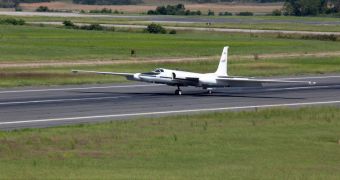The American space agency plans to conduct a series of high-altitude flights over the coming weeks, using one of its aircraft to test instruments that could eventually make their way to next-generation satellites. Using an airplane minimizes the development costs associated with these instruments.
One of NASA's ER-2 high-altitude research aircraft arrived at the agency's Wallops Flight Facility, in Wallops Island, Virginia, on September 7. It was deployed from its home base at the NASA Dryden Aircraft Operations Facility, in Palmdale, California.
The vehicle is capable of carrying the satellite instrument testbeds to altitudes exceeding 18,300 meters (60,000 feet), an environment that is very similar to what these devices would be exposed to in orbit.
Engineers say that these test flights will enable them to collect valuable data related to the instruments' behavior. These will aid them develop more advanced versions for use on upcoming NASA satellites.
The two scientific instruments in question are called the Cloud-Aerosol Transport System (CATS) and the Multiple Altimeter Beam Experimental Lidar (MABEL). Lidar stands for Light Detection and Ranging, and is a laser-based technique that accurately measures distances.
According to a statement issued by NASA, the ER2 flights will conclude no later than September 27.
CATS is a high spectral resolution lidar, which will be used to gather data on clouds and aerosols. The latter are tiny airborne particles, which play a significant role in determining the amount of heat our planet retains within the atmosphere, as well as controlling pollution levels.
Similar instruments, such as the Cloud-Aerosol Lidar with Orthogonal Polarization (CALIOP) on the NASA Cloud-Aerosol Lidar and Infrared Pathfinder Satellite Observations (CALIPSO) spacecraft, can image aerosol profiles, but are unable to determine what these aerosols are made of.
Because it can determine aerosol composition, CATS has the potential to improve studies of aerosol transport and cloud motions, aspects that are critical to figuring out how global warming and climate change will influence the planet.
CATS will fly to orbit aboard the future Aerosol-Cloud Ecosystems (ACE) satellite, currently still in planning. By mid-2013, the International Space Station will receive such an instrument as well.
The first version of MABEL will fly into space in 2016, aboard the NASA Ice, Cloud, and land Elevation Satellite 2 (ICESat-2) mission. ER2 will fly the MABEL test version over the US East Coast, allowing it to measure the amount and thickness of available vegetation covers.

 14 DAY TRIAL //
14 DAY TRIAL //